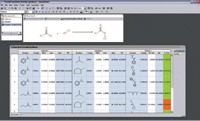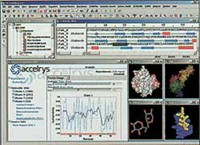Advertisement
Grab your lab coat. Let's get started
Welcome!
Welcome!
Create an account below to get 6 C&EN articles per month, receive newsletters and more - all free.
It seems this is your first time logging in online. Please enter the following information to continue.
As an ACS member you automatically get access to this site. All we need is few more details to create your reading experience.
Not you? Sign in with a different account.
Not you? Sign in with a different account.
ERROR 1
ERROR 1
ERROR 2
ERROR 2
ERROR 2
ERROR 2
ERROR 2
Password and Confirm password must match.
If you have an ACS member number, please enter it here so we can link this account to your membership. (optional)
ERROR 2
ACS values your privacy. By submitting your information, you are gaining access to C&EN and subscribing to our weekly newsletter. We use the information you provide to make your reading experience better, and we will never sell your data to third party members.
Physical Chemistry
Digital Briefs
New software and websites for the chemical enterprise
by Stephen M. Trzaska
September 18, 2006
| A version of this story appeared in
Volume 84, Issue 38
Software
Marvin 4.1 is a Web-ready, chemical editor and visualization tool kit and application suite that contains Java applications and software development tools. This release sees the addition of new structure-based calculations; extensive publication features; support for .net, which allows seamless integration within Web and intranet environments; and availability of a full application programming interface allowing users to configure and control only those features they want to use. MarvinSpace 1.3 is a high-performance, 3-D component of the suite for analyzing macromolecule/ligand interactions. One can visualize small molecules, proteins, nucleic acids, crystals, various molecular surfaces, and molecular orbitals as well as volumetric data such as electrostatic potential and hydrophobicity. Manual overlay of structures and manual change of internal coordinates are also possible. Beyond visualization, MarvinSpace allows the sharing of molecular information by labeling and annotating atoms, bonds, ligands, receptors, complexes, and surface regions. New features include ribbon representation, interactive editing of molecules, high-resolution image export in a range of file formats, and enhanced selection tools. MarvinSpace is Web-enabled and is available on a range of platforms including Windows, Linux, Mac OS X, and Solaris. ChemAxon, www.chemaxon.com
Scientist 3.0 for Windows is a general mathematical modeling and data analysis application that is designed to fit model equations to experimental data. Incorporating technical graphics, symbolic manipulation, and matrix operations, Scientist also fits equations to experimental data. The program can fit almost any mathematical model from the simplest linear functions to complex systems of differential equations, nonlinear algebraic equations, or models expressed as Laplace transforms. Scientist provides remarkably simple model equation entry, data management, control of initial parameter estimates and constraints on parameter values, as well as complete statistical analysis and publication-quality graphical output. Micromath, www.micromath.com
Flexweb is a portal that hosts a variety of information related to the study of rigidity, flexibility, and motion within molecular structures such as proteins, DNA, and RNA. The portal runs on the FIRST software program, a computational tool for analyzing the flexibility of molecular structures and exploring available conformational space. This simulation software can identify rigid and flexible bonds in network structures, through patented algorithms from rigidity theory and then explore the available conformational space of the flexible regions. Results are displayed to the user in real time during an analysis, and the final data can be stored on the server in the user's personal directory. The progress of a given analysis is presented to the user in real time via AJAX-enabled graphs and tables. There is also an active online forum dedicated to questions about the portal and its software. Center for Biological Physics at Arizona State University, flexweb.asu.edu
Databases
Lipid MAPS (Metabolites & Pathways Strategy) is a project funded by the National Institutes of Health to construct a complete map of genes, gene products, and their interaction networks in a functioning cell. It focuses on the lipid section of the metabolome by developing an integrated metabolomic system capable of characterizing the global changes in lipid metabolites. The website has been updated to include structure and proteome databases. The structure database is composed of structures and annotations of biologically relevant lipids and includes representative examples from each category of the Lipid MAPS lipid classification scheme. The proteome database is composed of lipid-associated protein sequences with annotations from a variety of public resources. Users can browse or search by species, lipid-class association, and keywords. Lipid Maps, www.lipidmaps.org
Online
The Polysaccharide Biobased Materials Center is dedicated to the promotion of and education about polysaccharide materials. The website features recent news of developments in and an introduction to polysaccharide chemistry, including structures and chemical and physical properties. The site also lists commercial applications and sources, including synthetic derivatives as well as manufacturers and suppliers. Polysaccharide Biobased Materials Center, www.polysaccharidecenter.com
HPLC Fundamentals is an interactive tutorial that introduces the field of high-performance liquid chromatography. The module defines and describes basic HPLC concepts, including distribution equilibria, retention, efficiency, resolution, and selectivity. Simulators based on efficiency and resolution equations graphically demonstrate how changing factors such as flow rate and solvent strength affect retention in the chromatogram. The program uses interactive animations and simulations and features a modernized interface, narration, an assessment quiz with automatic scoring and revision hyperlinks, a glossary, and a bibliography. Academy Savant, www.academysavant.com







Join the conversation
Contact the reporter
Submit a Letter to the Editor for publication
Engage with us on Twitter